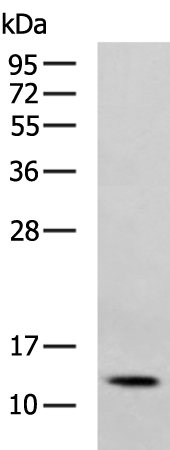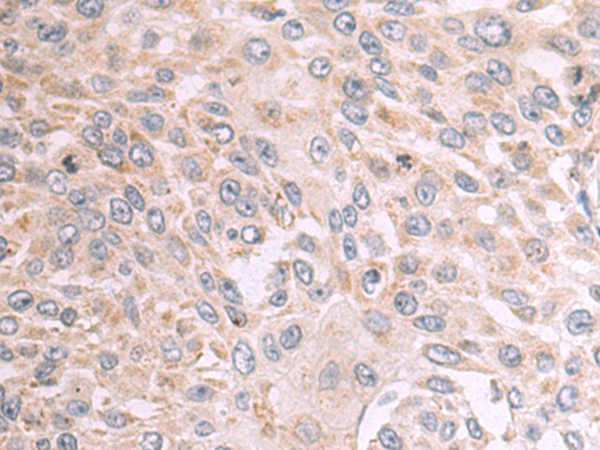

| WB | 咨询技术 | Human,Mouse,Rat |
| IF | 咨询技术 | Human,Mouse,Rat |
| IHC | 1/50-1/100 | Human,Mouse,Rat |
| ICC | 技术咨询 | Human,Mouse,Rat |
| FCM | 咨询技术 | Human,Mouse,Rat |
| Elisa | 1/5000-1/10000 | Human,Mouse,Rat |
| Aliases | TARC; ABCD-2; SCYA17; A-152E5.3 |
| WB Predicted band size | 11 kDa |
| Host/Isotype | Rabbit IgG |
| Antibody Type | Primary antibody |
| Storage | Store at 4°C short term. Aliquot and store at -20°C long term. Avoid freeze/thaw cycles. |
| Species Reactivity | Human, Mouse |
| Immunogen | Synthetic peptide of human CCL17 |
| Formulation | Purified antibody in PBS with 0.05% sodium azide and 50% glycerol. |
+ +
以下是3篇与CCL17抗体相关的代表性文献摘要:
---
1. **文献名称**:*CCL17/TARC in Atopic Dermatitis and Asthma*
**作者**:Kakinuma T, et al.
**摘要**:研究探讨了CCL17在特应性皮炎和哮喘中的作用,发现其通过招募Th2细胞加剧炎症。使用CCL17中和抗体可显著减少小鼠模型中皮肤炎症和气道高反应性,提示其作为潜在治疗靶点。
---
2. **文献名称**:*Targeting CCL17 Blocks Tumor-Promoting Microenvironment*
**作者**:Curiel TJ, et al.
**摘要**:该研究揭示了肿瘤微环境中CCL17通过招募调节性T细胞(Tregs)抑制抗肿瘤免疫。使用抗CCL17单克隆抗体可减少Tregs浸润,增强CD8+ T细胞活性,抑制小鼠黑色素瘤生长。
---
3. **文献名称**:*CCL17 Neutralization Limits Autoimmune Neuroinflammation*
**作者**:Greter M, et al.
**摘要**:在多发性硬化症模型中,CCL17驱动小胶质细胞依赖性神经炎症。研究通过抗体阻断CCL17信号,显著减轻中枢神经系统炎症和脱髓鞘病变,为治疗自身免疫性神经疾病提供新策略。
---
如需具体DOI或发表年份,可进一步补充检索条件优化结果。
CCL17 (C-C motif chemokine ligand 17), also known as thymus- and activation-regulated chemokine (TARC), is a small cytokine involved in immune regulation. It binds to the CCR4 receptor, guiding the migration of Th2 cells, regulatory T cells (Tregs), and dendritic cells to sites of inflammation. CCL17 is implicated in allergic diseases (e.g., asthma, atopic dermatitis), autoimmune disorders, and cancer, where it can promote immune evasion by recruiting immunosuppressive cells.
CCL17 antibodies are immunodetection or neutralizing tools developed to study or therapeutically target this chemokine. Polyclonal or monoclonal CCL17 antibodies are widely used in research for quantifying CCL17 levels (via ELISA, flow cytometry) or visualizing its expression in tissues (via immunohistochemistry). Neutralizing antibodies block CCL17-CCR4 interactions, potentially suppressing pathological immune responses. Preclinical studies suggest their utility in reducing inflammation in allergic models or inhibiting tumor progression by disrupting CCR4-mediated immunosuppression.
While no CCL17-targeting antibody has been approved for clinical use, ongoing research explores their therapeutic potential, particularly in combination with checkpoint inhibitors. Challenges include optimizing specificity and managing systemic effects due to CCR4's broad expression. These antibodies remain vital for deciphering CCL17's roles in disease and developing precision immunotherapies.
×